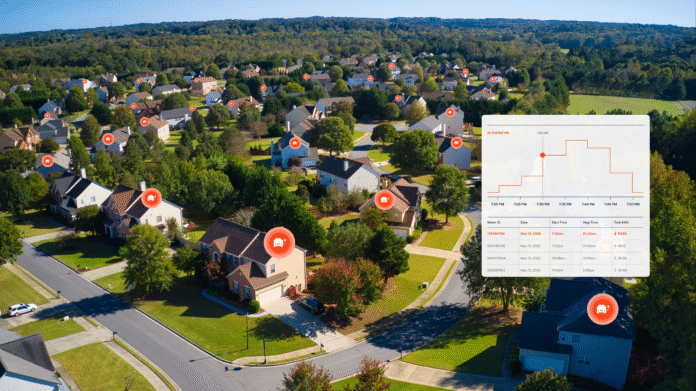Cambridge, Mass.– June 10, 2025 – Sense today announced the availability of EV Analytics, a new load management solution delivered through AMI 2.0 meters. This innovative product offers electric vehicle (EV) detection and precise charging insights, empowering utilities with smarter forecasting, improved distribution planning, and more efficient managed charging program delivery. EV Analytics marks Sense’s first grid-edge product specifically designed to address utilities’ critical needs for grid visibility and reliability.
By processing high-resolution waveform data directly at the grid edge, EV Analytics accurately detects the presence of EVs. It then estimates both Level 1 and Level 2 charge events, including their start/stop times and kilowatt-hour consumption. This capability marks the first in a suite of Sense software solutions designed to support utility electrification and grid reliability needs directly from the grid edge.
Nancy Riley, SVP of Product at Sense, commented on the new offering: “You can’t measure what you can’t see, which is where our new EV Analytics solution comes in. We’ve focused our energy on finding all EVs on a grid, including those ghost EVs that utilities are often blind to because they use Level 1 chargers. This is just the start of the software innovation you can expect from Sense moving forward; innovation that’s focused on delivering tools to utilities that accelerate electrification, grid reliability, and grid capacity from the edge.”
Key Benefits of EV Analytics for Utilities
Sense EV Analytics provides several key benefits for utilities seeking to optimize their grid management:
- Harness the power of edge computing: The solution analyzes high-resolution waveform data locally on the meter using embedded AI and machine learning. This delivers accurate detection and measurement, dramatically outperforming traditional 15-minute interval cloud models.
- Support all vehicles and chargers: It identifies and quantifies EV charge events regardless of brand or charger type, removing the need for costly telematics or complex integrations.
- Improve program efficiency: Utilities can reduce costs and increase enrollment in managed charging programs with reliable, grid-edge detection and measurement of EV charging.
- Build reliable, scalable solutions: The system leverages flexible communication protocols—including cellular, mesh, and WiFi—for seamless integration across various utility systems.
Embedded directly in capable AMI 2.0 smart meters, Sense EV Analytics enables utilities to detect charging behavior across all vehicles and chargers without relying on proprietary telematics or cloud-based integrations. Such barriers often limit consumer participation. By eliminating these, Sense opens the door for all consumers within a utility’s service area to engage in utility programs. These programs can better motivate them to manage their EV charging costs and support grid reliability.
EV Analytics is the first solution in a suite of capabilities Sense will deliver over the coming months designed to transform grid-edge data into real-time action. It is currently available to utilities leveraging Landis+Gyr Revelo meters through the Sense EV Analytics App.
Q&A with Nancy Riley, SVP of Product at Sense
EV Charging Magazine spoke with Nancy Riley, Sense’s SVP of Product, to delve deeper into the features and implications of Sense EV Analytics.

Can you elaborate on the “ghost EVs” phenomenon that Sense EV Analytics aims to address? What are the implications of utilities being blind to Level 1 charging, and how significant is this issue currently?
One in five EV owners are using level one chargers at home that are completely invisible to utilities because they plug into 120v outlets that don’t trigger noticeable usage spikes. And in many cases, EV owners with level 2 chargers haven’t notified their utility, making that one in five an underestimation of the actual ghost EV load. That causes a couple of issues. First, utilities are blind to the residential EV load that’s putting a strain on the grid. Second, utility customers are missing out on the opportunity to participate in programs that may offer them discounted rates or rewards for managed charging. We are solving that problem from the grid edge with software that identifies these charging points in real time.
How does Sense EV Analytics fundamentally differ from existing methods utilities might use (or attempt to use) for EV load management and detection?
One of the key differences in our approach is the granularity of the data that informs our models. Most of the existing solutions rely on 15-minute interval data that is processed in the cloud – that’s just not enough data to accurately detect when and for how long an EV charges – especially with each vehicle/charger behaving slightly differently. You also can’t use 15 minute-interval data to do anything in real-time that would allow you to manage capacity on the local distribution line. At Sense we’re using real-time waveform data captured and processed at the grid edge to get the granularity needed to detect EVs and to take action without concerns about data transfer limits or the possibility of data gaps.
Could you explain in a bit more detail how processing “waveform data at the grid edge” allows for such accurate detection and measurement compared to traditional cloud models?
Traditional cloud models are limited by the resolution of the data that can be made available in the cloud. That data must be transmitted from the meter to the cloud over bandwidth-limited networks, and higher-resolution data requires more bandwidth. By processing waveform data at the grid edge, powered by AMI 2.0 meters, we remove this bandwidth limitation and provide our models with much, much higher-resolution data containing far richer signals.
Beyond the listed benefits, what’s the most critical problem Sense EV Analytics solves for utilities from a grid planning or reliability perspective?
Utilities appreciate the impact EV Analytics can have on local distribution planning. With granular visibility into exactly where EVs are located – down to the transformer level – utilities can prioritize upgrades and stop potential disruptions to service on a transformer or feeder before it’s too late. In the future, this level of precision will become even more important as vehicle to grid programs become a critical resource in balancing and decarbonizing peak loads.
What kind of data volume and analytical power is required for Sense EV Analytics to operate effectively directly on the AMI 2.0 meters?
Sense EV Analytics processes 7kHz waveform data on the meter’s CPU. The horsepower available on the current generation of AMI 2.0 meters – roughly equivalent to an ARMv7 processor – is more than sufficient for this analysis. But it’s important to know that needs and capabilities are evolving, including sampling rates up to 1MHz, which opens doors to incredible innovation across a variety of grid use cases. As these meters come online, our abilities get super charged – for example, we’ll be able to detect more transient events and localize disruptions more precisely.
As SVP of Product, what was the biggest technical or product development challenge in bringing Sense EV Analytics to market?
AMI 2.0 unlocks revolutionary opportunities for utilities and their customers. At the same time, it requires investment in foundational IT architecture and expertise to bring those opportunities to life. This challenge is shared by all of the key players – utilities, AMI 2.0 meter makers, and companies like Sense who provide software applications running on those meters. We’re working closely with our partners to bring a brand-new platform architecture to market, not just our own products including EV Analytics. While reliably detecting EV charging regardless of brand and charger is an incredibly hard problem, the challenge of packaging that functionality for a cutting edge platform that includes core meter firmware working in concert with a discrete edge app is hard in a different way. I’m incredibly proud of the whole Sense team who flexed their expertise and ingenuity to create a product that leverages the strengths of AMI 2.0 to provide unique value to utilities and EV drivers alike.

